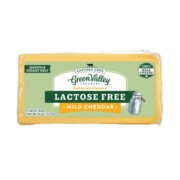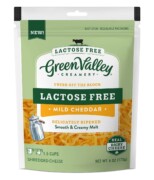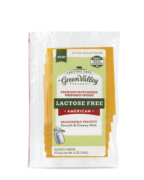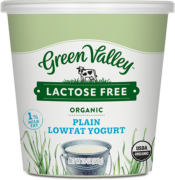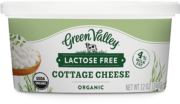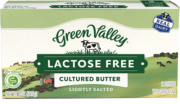Lactose Free Living
Lactose vs Dairy-free: Key Differences Explained!
Confused about the difference between lactose free and dairy free? You’re not alone! With so many types of “milk” products on the market, it can feel overwhelming. We’re going to break down the differences for you, providing both the pros and cons. Get ready to learn everything you wanted to know about lactose free vs. dairy free!
First up, what does lactose free mean? Lactose is a type of sugar in milk made up of two molecules, glucose and galactose. It’s found in cow’s milk as well as sheep’s and goat’s. In order for our body’s to break down lactose and make it easy to digest, we need to have the enzyme lactase in our small intestine. Unfortunately, up to 65% of the world’s population is missing this enzyme! (1). If you do not have the lactose enzyme, then you may experience digestive symptoms like gas, bloating, cramping or diarrhea. So, when a product says that it is lactose free, it usually means that it is still a dairy product (i.e. cow’s milk), but that it has the enzyme lactase added to the product. Lactose-free dairy products may include milk, cream cheese, sour cream, yogurt, kefir and butter.
Dairy free is just that, it’s a product that is free from dairy! The product does not contain any milk or milk products from cows, sheep or goats. A person that follows a dairy free diet may still eat other animal products (like poultry, beef or fish) but they do not consume any dairy based milk products. Dairy free products are typically made from plants like nuts (almond, cashew), seeds (flax or hemp), legumes (soy or pea), fruit (coconut) or oats. They can include products similar to lactose free milk products, just made with a dairy free alternative.
Nutritional comparison
There are many reasons to follow a lactose free or dairy free diet, but we’re first going to look at the nutritional differences.
Lactose-free milk has the same nutritional value of regular cow’s milk, just with the addition of the lactase enzyme.One cup of lactose free milk is rich in protein, calcium and other nutrients. It’s also a great source of minerals like phosphorus (important for the health of your bones and teeth) and B vitamins (energy production). There are a plethora of dairy free products on the market, so we’re going to compare the most popular and commonly used: almond milk. Dairy free almond milk is a great source of calcium, but most of it has been added to the product. It’s also low in calories and fat, which may be beneficial in weight loss or cardiovascular diets. However, it’s very low in protein and not necesarilly nutritionally balanced.
Next up is lactose free cream cheese! Green Valley Lactose Free Cream Cheese is simple and creamy. It contains only four ingredients: cultured cream, salt, lactase and live & active cultures. There are dairy free cream cheese products on the market, like this one made from almond milk. Compared to lactose free cream cheese, it has more than double the ingredients. The nutritional breakdown comparing the two is pretty similar, but the taste is not. The fat from lactose free cream cheese has a preferable mouth feel compared to dairy free cream cheese that requires various gums to create texture.
Lactose-free dairy and dairy-free yogurts are two other popular products that many people consume daily. Nutritionally, many people eat yogurt for the probiotic benefits, calcium and/or high protein content. Below is a nutritional breakdown of Green Valley Lactose Free Organic Plain Lowfat Yogurt vs. Silk’s Plain Almondmilk Dairy Free Alternative
While both yogurts contain probiotics (as live active cultures), the lactose free yogurt contains double the amount of calcium compared to the almond milk yogurt. Lactose free yogurt also contains more protein compared to it’s dairy free alternative.
Diets & Medical Conditions
There are various medical conditions and subsequent diets that may require a lactose free or dairy free approach. It’s important to take into consideration your overall nutritional needs as well as the benefits and detriments of every individual’s choice.
The types of medical conditions and/or diets that include lactose free are:
- Lactose intolerance:
-
This affects about 65% of the world’s population due to a lack of the enzyme lactase. In order to avoid digestive symptoms like gas, bloating and diarrhea caused by lactose intolerance, it’s recommended to choose lactose free dairy products that contain the enzyme lactase.
-
- Low FODMAP for Irritable Bowel Syndrome (IBS):
-
A Low FODMAP Diet is not a dairy free diet, but it is very low on lactose. While some cheese may be tolerated due to their low lactose content, other lactose free dairy products may be consumed. These include items like milk, yogurt, kefir, cottage cheese and sour cream (2).
-
- Digestive disorders like Crohn’s or Celiac’s disease:
-
Crohn’s disease and Celiac’s disease are located in the small intestine, where the lactase enzyme is produced. If you are newly diagnosed with Celiac’s disease, you may be temporarily unable to tolerate lactose until your small intestine has healed. People with Crohn’s disease often find that a lactose free diet helps with symptom management (3)
-
- Post intestinal surgery:
-
Any surgery where part of the intestines is removed may require temporary lactose intolerance. This may be because your small intestine has decreased lactase production after your illness/surgery or because part of the small intestine was removed.
-
- Chemotherapy/Radiation:
-
When you undergo chemo or radiation therapy, you may develop digestive issues that may reduce the ability to process lactose. This then requires a lactose free diet. One way to still get in adequate calories or protein is choosing lactose free products like cottage cheese, yogurt or milk.
-
The types of medical conditions or diets that may require dairy free are:
- Vegan:
-
Those that follow a vegan diet may do so for health benefits or ethical beliefs. Vegans do not consume animal products of any kind (including dairy).
-
- Ovo-Vegetarian:
-
There are various types of vegetarian diets that people follow. One such diet is Ovo-vegetarians, who do not consume any dairy products or meat, but still consume eggs.
-
- Paleo, Whole30:
-
The Paleo and Whole30 diet programs are focused around consuming fruits,vegetables, animal protein (like chicken, beef or fish), nuts and seeds. They avoid whole grains and dairy products.
-
- Food allergy to milk protein
-
A milk allergy is different from lactose intolerance. When someone has a milk protein allergy, their body’s immune system has an abnormal response to dairy and dairy products. Symptoms of a milk protein allergy may include digestive issues as well as hives, wheezing or anaphylaxis/
-
- Cultural or religious preferences:
-
Certain cultures or religions abstain from all dairy products due to their beliefs. One such group are the Seventh Day Adventists, who follow a vegan diet.
-
Pros and Cons: Lactose Free
There are both pros and cons to consuming a lactose free diet. The pros are that it allows for less restriction in your overall diet and may allow you to get in more protein and calcium compared to dairy free. Lactose free dairy is easier to digest, especially if you have lactose intolerance or another digestive issue. It is also a more ideal form of nutrition for those with other food allergies (nut, seed or legumes). The biggest con of a lactose free diet is that it is not appropriate for milk protein allergies or for those with other dietary restrictions due to cultural/religious beliefs.
Pros and Cons: Dairy Free
The benefits of a dairy free diet are both nutritional and cultural. Nutritionally, it may provide more plant diversity. Cultures and religions that are dairy free have more options now than ever before in regards to dairy free alternatives. The cons of dairy free are that it may be more difficult to meet your nutritional needs depending on the type of dairy free product you choose. Dairy free products often contain less protein, calories and/or calcium compared to their lactose free alternatives. Dairy free is also not the ideal choice if you have various other allergies (like nuts, soy or seeds). Unfortunately some dairy free products are still processed in facilities that also process dairy, which may put those with dairy allergies at risk. In those with Celiac’s disease, they need to be careful with Oat milk based products as there are often risks of gluten exposure. Finally, the consistency of dairy free products can be difficult to match that of lactose free dairy. Brands may then try to adjust the product to include more fat, sugar or gums to make it more palatable.
We hope that you have better insight into what the differences are between lactose free and dairy free diets. It’s important to think about your unique situation when choosing lactose free or dairy free. This includes your nutritional needs and/or goals, possible digestive issues as well as likes and preferences!
About the Author: Liz McMahon is a Registered Dietitian Nutritionist with a Master’s in Public Health Nutrition. She runs a virtual nutrition consulting practice that focuses on gut health and her speciality is IBS and the Low FODMAP diet.
References:
-
Lactose intolerance: MedlinePlus Genetics. (2020, August 18). Retrieved May 05, 2021, from https://medlineplus.gov/genetics/condition/lactose-intolerance/#frequency
-
High and low FODMAP foods. FODMAP food list | Monash FODMAP – Monash Fodmap. (n.d.). https://www.monashfodmap.com/a…;
-
von Tirpitz C, Kohn C, Steinkamp M, Geerling I, Maier V, Möller P, Adler G, Reinshagen M. Lactose intolerance in active Crohn’s disease: clinical value of duodenal lactase analysis. J Clin Gastroenterol. 2002 Jan;34(1):49-53. doi: 10.1097/00004836-200201000-00009. PMID: 11743245.

